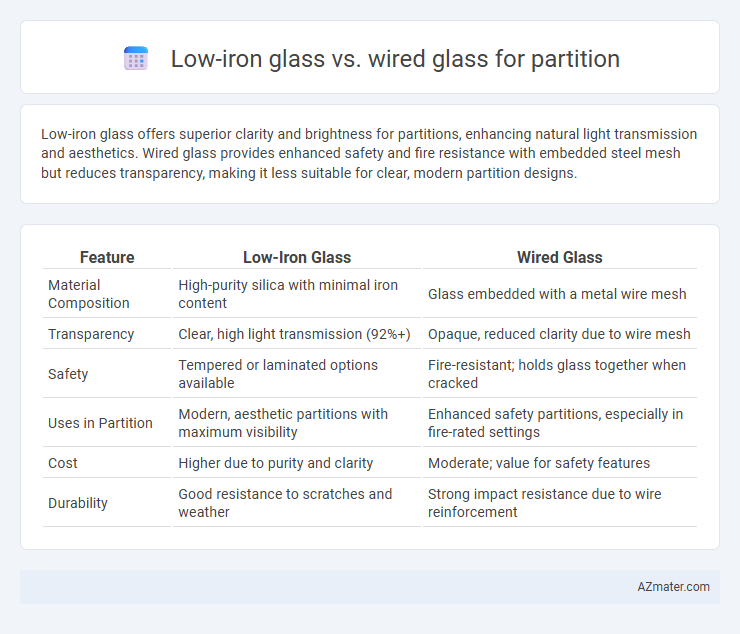Low-iron glass offers superior clarity and brightness for partitions, enhancing natural light transmission and aesthetics. Wired glass provides enhanced safety and fire resistance with embedded steel mesh but reduces transparency, making it less suitable for clear, modern partition designs.
Table of Comparison
| Feature | Low-Iron Glass | Wired Glass |
|---|---|---|
| Material Composition | High-purity silica with minimal iron content | Glass embedded with a metal wire mesh |
| Transparency | Clear, high light transmission (92%+) | Opaque, reduced clarity due to wire mesh |
| Safety | Tempered or laminated options available | Fire-resistant; holds glass together when cracked |
| Uses in Partition | Modern, aesthetic partitions with maximum visibility | Enhanced safety partitions, especially in fire-rated settings |
| Cost | Higher due to purity and clarity | Moderate; value for safety features |
| Durability | Good resistance to scratches and weather | Strong impact resistance due to wire reinforcement |
Introduction to Glass Types for Partitions
Low-iron glass offers high clarity and minimal green tint, making it ideal for partitions where a sleek, modern aesthetic and maximum light transmission are desired. Wired glass contains embedded wire mesh, enhancing safety and fire resistance but often sacrificing clarity and a smooth surface finish. Choosing between low-iron and wired glass depends on balancing visual appeal with structural and safety requirements for partition installations.
What Is Low-Iron Glass?
Low-iron glass is a type of glass with reduced iron content, resulting in higher clarity and enhanced light transmission compared to standard glass, making it ideal for partitions requiring a clear, bright appearance. Wired glass contains embedded metal wire mesh for added safety and fire resistance but typically has lower clarity due to its fused wires and higher iron content. For partitions where aesthetics and transparency are prioritized, low-iron glass offers a sleek, modern look, whereas wired glass is chosen for durability and safety compliance.
What Is Wired Glass?
Wired glass is a type of safety glass embedded with a metal wire mesh designed to hold the glass together upon impact, preventing shattering and enhancing fire resistance. Unlike low-iron glass, which offers superior clarity and minimal green tint for aesthetic applications, wired glass prioritizes durability and safety in partition installations by maintaining structural integrity during thermal or mechanical stress. Its compliance with fire-rated building codes makes wired glass a preferred choice for partitions in commercial and industrial environments where safety and fire protection are critical.
Clarity and Aesthetics Comparison
Low-iron glass offers superior clarity with higher light transmission and minimal green tint, making it ideal for partitions requiring a pristine, color-neutral view. Wired glass, embedded with metal mesh for safety, sacrifices some transparency and aesthetic appeal due to its textured surface and slight distortion. For partition designs emphasizing aesthetics and clear visibility, low-iron glass is preferred, while wired glass serves better where fire resistance and security are paramount.
Strength and Safety Considerations
Low-iron glass offers exceptional clarity and aesthetic appeal but generally has lower impact resistance compared to wired glass, which incorporates a metal mesh for added strength and fire resistance. Wired glass provides enhanced safety by preventing glass shattering during breakage, making it suitable for fire-rated partitions and areas requiring high durability. Strength considerations favor wired glass for safety-critical applications, while low-iron glass is preferred where visual transparency and design are priorities.
Fire Resistance and Building Codes
Low-iron glass offers superior clarity and aesthetic appeal but has limited fire resistance compared to wired glass, which is specifically engineered to withstand high temperatures and maintain structural integrity during fires. Wired glass meets many building codes for fire-rated partitions, providing up to 90 minutes of fire protection by preventing the spread of flames and smoke. Compliance with local fire safety regulations often dictates the use of wired glass in partitions where enhanced fire resistance is required.
Acoustic Performance Evaluation
Low-iron glass offers superior acoustic insulation due to its high density and clarity, effectively reducing sound transmission in partition applications. Wired glass, embedded with metal mesh for safety, generally exhibits lower acoustic performance as the mesh can create sound vibrations and diminish soundproofing effectiveness. Acoustic performance evaluations typically favor low-iron glass for partitions where noise control is critical, while wired glass is chosen primarily for fire resistance rather than sound insulation.
Cost Differences and Budget Impact
Low-iron glass typically costs 20-30% more than wired glass due to its higher clarity and purity, impacting budget allocations for partition projects requiring aesthetic appeal. Wired glass offers enhanced fire resistance and safety at a lower price point, making it a cost-effective option for commercial interiors with strict safety codes. Choosing low-iron glass increases upfront material expenses but enhances visual quality, while wired glass provides a balance between affordability and performance, influencing overall project budgeting decisions.
Application Suitability: Where Each Excels
Low-iron glass offers superior clarity and color neutrality, making it ideal for partitions in high-end retail spaces and modern office environments where visual appeal and natural light transmission are critical. Wired glass provides enhanced safety and fire resistance, excelling in industrial or institutional settings such as schools, hospitals, and factories where building codes require fire-rated partitions. Choosing between low-iron and wired glass depends primarily on whether aesthetic transparency or fire protection is the priority in the partition application.
Choosing the Right Glass for Your Partition
Low-iron glass offers exceptional clarity and a nearly colorless appearance, making it ideal for partitions that require maximum visibility and a modern aesthetic. Wired glass, embedded with a metal mesh, provides enhanced safety and fire resistance, suited for partitions in environments where durability and fire protection are critical. Selecting between low-iron and wired glass depends on prioritizing either optical clarity or safety features to ensure the partition meets both design and functional requirements.

Infographic: Low-iron glass vs Wired glass for Partition
 azmater.com
azmater.com